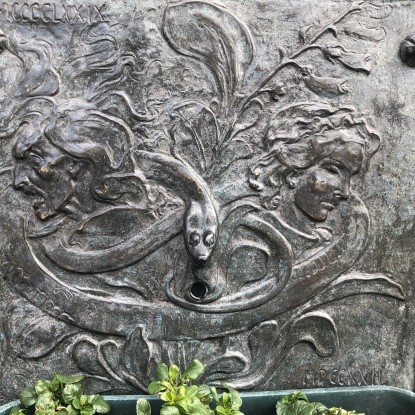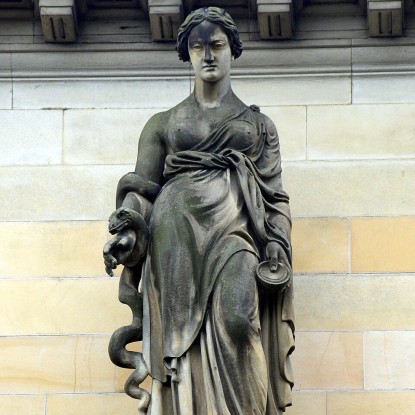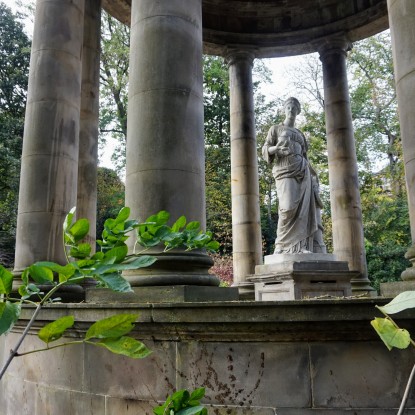Hygeia and the Witch
It’s well known that Edinburgh has very few public statues of women, and of those that we do have, almost all are of unnamed women; women as artistic motifs or mythological figures, as opposed to real people. Of those real women with names, almost all are queens, and a considerable chunk of those are one woman, Queen Victoria. In fact, more named dogs (2) have statues in Edinburgh than real women who aren’t royals (1).
One woman who has at least three prominent public depictions is a figure from Greek Myth; Hygeia, the goddess of health. As the name suggests, the image of Hygeia is often deployed in early-modern and Georgian Edinburgh to symbolise hygiene, cleanliness and good health. Prominent displays of figures of antiquity like Hygeia evince a self-identity that counterposes modernity and the enlightenment with the dirty, benighted medieval world of petty superstition and disease, an identity that has long been important to Edinburgh, the so called Athens of the North.
However, exploring the three depictions of Hygeia, those at St Bernard’s Well, the Royal College of Physicians of Edinburgh, and the Witches’ Well, reveals another side to enlightenment Edinburgh, a Gothic Edinburgh of brutal, systematic violence and persecution. As we’ll see, notions of health associated with Hygeia, and the image of Edinburgh as a city of modern science, professions and, crucially, medicine, are intimately tied to one of its most shameful episodes: the early-modern witch hunts.
St Bernard’s Well
Our first depiction of Hygeia is at St Bernard’s Well in scenic Dean Village. St Bernard’s Well was built in 1789 on the site of a natural spring believed to have healing powers. In rapidly industrialising early-modern Edinburgh, clean water was in short supply, and the nearby Water of Leith was, for a long time, fed a steady stream of human effluent from a series of “foul burns”; channels that carried waste into the river. It’s little surprise, then, that the city celebrated the pristine water of St Bernard’s Well with not only a magnificent classical structure, but a statue of Hygeia. Of course, Hygeia is here only a motif representing cleanliness. The well itself bears the name of a man: St Bernard.
The Royal College of Physicians
Our second Hygeia is found above the portico on the front facade of the Royal College of Physicians of Edinburgh. As emblematic an institution of the Scottish Enlightenment as you could find, the college was founded in 1681, moving to its present premises on George Street in the Bourgeois New Town in 1775. Again Hygeia appears as a symbol of the enlightenment, and of enlightenment Edinburgh’s claim to the title Athens of the North, standing on a classical style building alongside other figures of antiquity; fellow Greeks Asklepios, her father and god of medicine, and Hippocrates, the real-life figure who gives his name to the modern Hippocratic Oath (named men already winning 1:0 on the RCPE portico alone).
The Witch’s Well
Our final Hygeia has a somewhat less salubrious association. She is depicted on the Witches’ Well on the castle esplanade at the top of the Royal Mile. The well, commissioned in 1894 by the much celebrated son of the city Patrick Geddes, who enjoys his own statue on the Mound (another victory for named men), is a memorial drinking fountain dedicated to the victims of the Scottish witch trials. I say it is a memorial, but the plaque below is revealing:
The wicked head and serene head signify that some used their exceptional knowledge for evil purposes while others were misunderstood and wished their kind nothing but good.
It’s an unfortunate statement, reproducing much the same misogynistic suspicion that hounded the victims the monument purports to commemorate. Though witches were evil and wicked, some, it assumes, were good people.
The “serene head” is commonly taken to be Hygeia. It’s telling that Hygeia is a goddess of health and not of medicine, a passive virtue suitable for women. Medical knowledge appears only in a negative light. The plaque goes on to explain the serpent coiled around both women.
The serpent has the dual significance of evil and wisdom.
The serpent is of course a reference to that found in Genesis that tempted Eve to eat the fruit of the tree of knowledge of good and evil: her knowledge bringing about the fall of man, but it also has an association with medicine. We see the wisdom of the serpent again outside the College of Physicians, coiled around the staff of Asklepios, a ubiquitous symbol of the medical profession. Americans will recognise Asklepios’ staff from the logos of many hospitals and medical schools. So the “exceptional knowledge” of the wicked head the plaque refers to is clearly medical knowledge.
In the popular imagination, the witch trials and the enlightenment are polar opposites. On one side is the medieval superstition, and irrationality of the pitchfork bearing peasant mob, on the other, rationality and reason, liberalism and the rule of law, but this view is far from the reality. Scotland’s witch trials peaked in the mid-17th century, around the same time as the College of Physicians’ founding, and tended to be most intense in those parts of Europe furthest along in the awkward transition to modernity. In Scotland, they were most intense closest to the capital in Edinburgh and Lothian, where around ⅓ of the accused resided, while there is little evidence of witch hunts in the Western Highlands where traditional social and political structures still held fast.
Witch hunters were systematic and methodical, operating through a robust legal system, and making use of that invention most emblematic of early modernity, the printing press, producing manuals for the identification of witches. Printing these manuals allowed not only the dissemination of ideas, but ensured that those ideas were uniformly reproduced so that persecution could be enacted systematically, according to a consistent set of principles.
One early manual was the Deamonologie written in 1597 by none other than King James VI of Scotland (and I of England), probably best known to Americans as the commissioner of the King James Bible (James, of course, has a statue outside the National Portrait Gallery on Queen Street, up the road from the College of Physicians).
Why then would the burgeoning early-modern Scotland so systematically persecute women? Sylvia Federici offers a compelling explanation in her famous monograph Caliban and the Witch. Federici argues that part of the transition to modernity involved the professionalisation, credentialisation and masculinisation of medicine. The enclosure of medical knowledge behind the gates of burgeoning scientific and medical institutions (like the college of physicians) recast the medical practices of women, based largely on traditional knowledge, in a suspicious light, especially when those practices included methods by which women could exert control over their own bodies, such as contraception and abortion. The self-identified rigorous and systematic new science of medicine, and the formal rule of law combined to eradicate the unruly, traditional practices carried out beyond the scope of their institutions. Thus virtuous, passive Hygeia is exonerated, and the wicked face of women’s medical knowledge is condemned.


